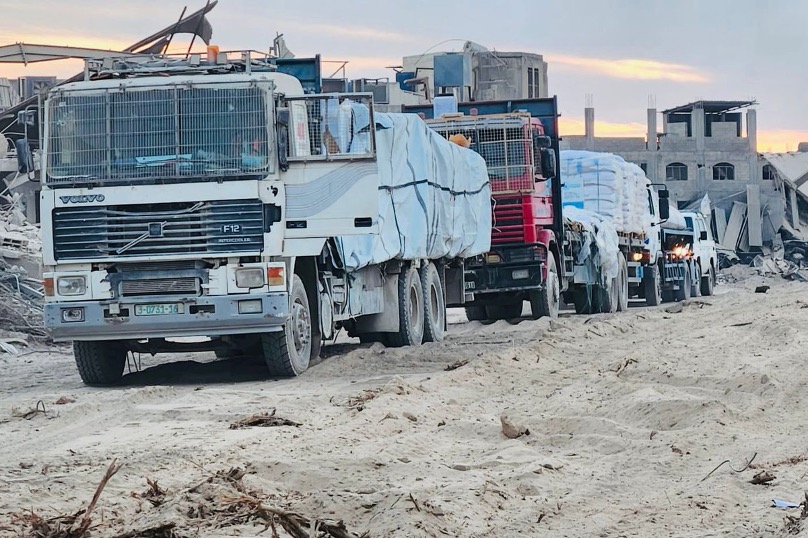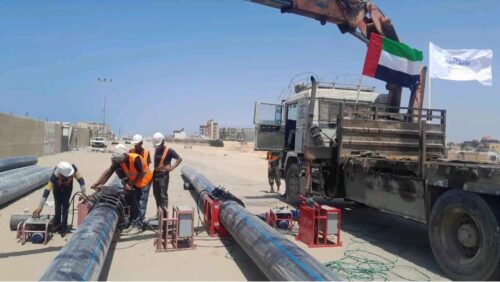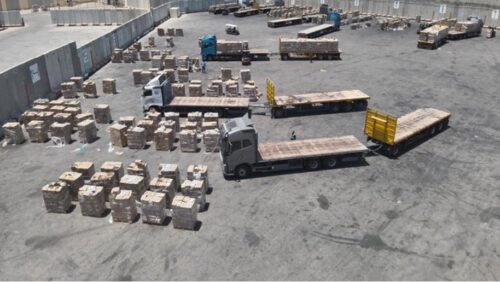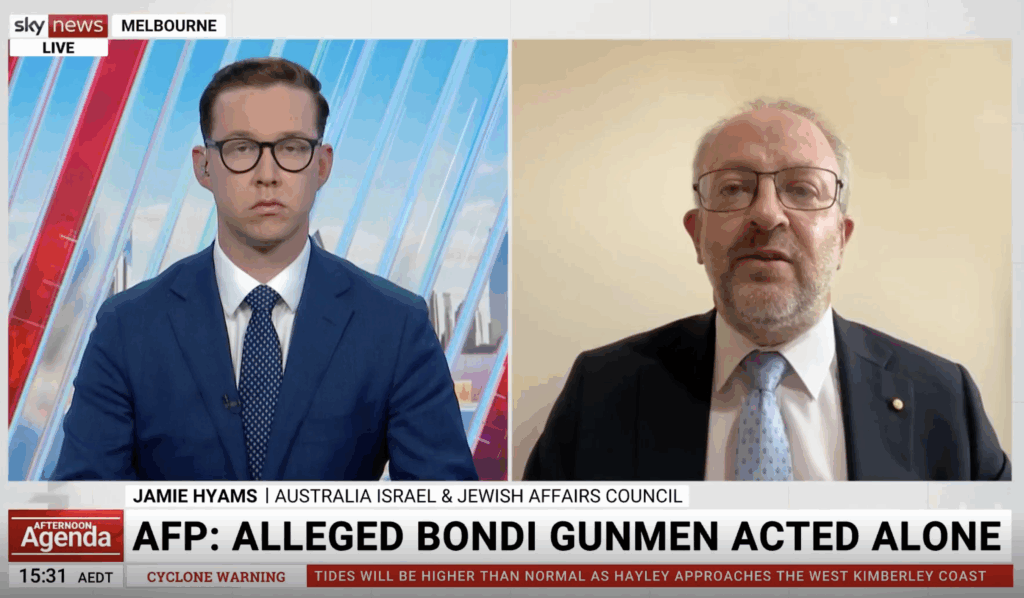FACT SHEETS
Fast Facts: Israel’s response to Gaza’s humanitarian situation
August 1, 2025 | AIJAC staff

Fast Facts are snapshots of rapidly evolving situations. This specific page will not be updated, but we are monitoring developments and will issue a new fact sheet if doing so is useful.
Key points
- After coming under intense international pressure over the deteriorating humanitarian situation in Gaza, Israel has moved to better facilitate the entry into and distribution of aid in Gaza
- A daily pause in military action in highly populated areas, and a permanent route for aid trucks were instituted, and a powerline to a desalination plant was reconnected
- Several other countries, plus international humanitarian organisations, are also increasing their contributions
- UN statistics show that Israel has been transferring aid into Gaza
Contents
- Summary
- What Israel has announced since July 27
- What other countries and organisations are doing
- UN statistics
- Background
Summary
In the past week, the Israeli Government has come under intense international pressure and condemnation for the humanitarian situation in Gaza. There have been numerous reports claiming that there is widespread starvation in Gaza, a claim that the Israeli Government strongly denies.
Israeli Prime Minister Binyamin Netanyahu also rejected claims that his Government is starving Palestinians. He said, “there is no policy of starvation in Gaza, and there is no starvation in Gaza.” He added that the Government had “enabled the amount required by international law” to enter Gaza and that the country enabled “humanitarian aid throughout the duration of the war… Otherwise, there would be no Gazans.”
Netanyahu blamed terrorist group Hamas for stealing significant amounts of aid and “accusing Israel of not supplying it.”
However, Netanyahu later acknowledged that the situation in Gaza is “difficult” and promised “to work with international agencies, as well as the US and European nations, to ensure that large amounts of humanitarian aid flow into the Gaza Strip” before announcing the measures summarised below.
Israel’s Coordinator of Government Activities in the Territories (COGAT) has acknowledged that there are several parts of the strip where access to food “continues to be difficult and challenging.”
Hamas has been stealing significant amounts of aid, including food and money, not just during the war, but since it took control of Gaza in 2007, which has been documented by both Palestinian sources and the UN itself in the past.
On Sunday, July 27, the Israeli Government announced new measures to address the humanitarian situation. This fact sheet details those announcements and also briefly covers what other countries and organisations are doing.
Read more: Fact Sheet: Aid into Gaza
What Israel has announced since July 27
The Israeli Government has announced several initiatives to improve the humanitarian situation in Gaza, including:
- Daily military pauses will be implemented in three major Gaza centres (al-Mawasi, Deir al-Balah, and Gaza City), which will allow the UN and international aid agencies to “improve the effectiveness of aid distribution.” It is the first military pause for the purpose of aid distribution since March;
- The reconnection of a power line to allow Gaza’s southern desalination plant to operate again has been carried out. This should allow an increase in water output from 2,000 to 20,000 cubic metres daily. This can supply approximately 900,000 people;
- Air drops of food into Gaza on July 26, with Jordan and the United Arab Emirates doing the same on July 27 into southern and northern Gaza. Further air drops occurred in the following days; and,
- Permanent secure routes for humanitarian aid convoys have been designated, which will operate between 6am and 11pm. These will allow UN and humanitarian aid organisation convoys to safely deliver and distribute aid, including food and medicine, across the Strip. The IDF said it was, “prepared to expand the scale of this activity as required”.
This surge in aid was praised by the UN’s World Food Programme, stating that it has, “enough food in – or on its way to – the region to feed the entire population of 2.1 million people for almost three months.”
Read more: Fast Facts: Aid back into Gaza – what we know
What other countries and organisations are doing
Egyptian media reported that trucks carrying aid crossed the Kerem Shalom crossing into Gaza for the first time since May 2024. However, Qatari newspaper al-Arabi al-Jadeed reported that the majority of the aid was looted before it reached distribution warehouses. It was reported that only 37 trucks, out of a convoy of 130, made it to the Egyptian committee and the Palestinian Red Crescent. An organised robbery took place in the Morag axis area, between Rafah from Khan Yunis in southern Gaza. The stolen items, including flour, food baskets and personal care items, were later sold at a local market.
On July 28, US President Donald Trump announced that the US would be “even more involved” in the delivery of aid to Gaza, saying that his Administration would work with European allies to set up food centres that will have easier access. According to an internal US State Department communication, revealed by the American ABC News, Jordan plans a three-week airdrop mission starting early August, with possible support from Spain, Belgium, France, Germany and the United Kingdom.
The UN and other agencies collected more than 100 trucks worth of aid that had been sitting idle on the Gaza side of the Gaza–Israel border. Another 90 trucks were also unloaded at the border, awaiting collection. Several hundred more trucks are still awaiting pick-up.
Enia Krivine, Senior Director of the Foundation for Defence of Democracy’s Israel Program and National Security Network, said Hamas has not taken any responsibility for what has happened to Gazan civilians.
As far as Hamas is concerned, the welfare of Gaza’s civilians is the responsibility of the United Nations, the international community, and even Israel. The terror organization takes no responsibility for launching and prolonging this war that has devastated Gaza. Hamas could end the war immediately by freeing the hostages from their captivity, now for nearly 660 days.
Read more: Fast Facts: PM Albanese’s claims about Gaza and international law
UN statistics
United Nations Operations (UNOPS) has an online ‘dashboard’ that shows statistics related to its operations in Gaza.
As of July 31, it showed that from May 19 (i.e. when Israel lifted the temporary blockade of aid entering Gaza), 2134 trucks of aid had crossed from Israel into Gaza for UN purposes, but only 2010 trucks of aid had been picked up by the UN. This shows that Israel has facilitated more aid going in to Gaza than the UN has attempted to distributed.
Further, the UN statistics reveal that of the 2010 trucks it has picked up, only 210 (i.e. 13%) reached their destinations. The rest were looted by either armed gunmen or civilians. The UN does not break down how many trucks were looted by each category.
This is significant because many people have accused Israel of preventing food aid from entering Gaza.
Background

The Emirati water line in Egypt being connected to the Al-Mawasi area along the coast (Image: COGAT)
The war between Hamas and Israel started on October 7, 2023 – when thousands of terrorists invaded southern Israel and raped, tortured, and murdered more than 1,200 children, women and men, and kidnapped another 251 people.
As in all wars, getting humanitarian aid to people in need is a deeply complex logistical challenge; the situation in Gaza has been made even more challenging because Hamas terrorists and armed gangs routinely steal food and other aid supplies and sell it to Palestinian civilians at exorbitant prices.
A new aid distribution system, the Gaza Humanitarian Foundation (GHF), started on May 27 with the goal of distributing aid directly to Palestinian civilians and to prevent Hamas terrorists from stealing it.
Read more: Fast Facts: New Gaza aid distribution system begins








